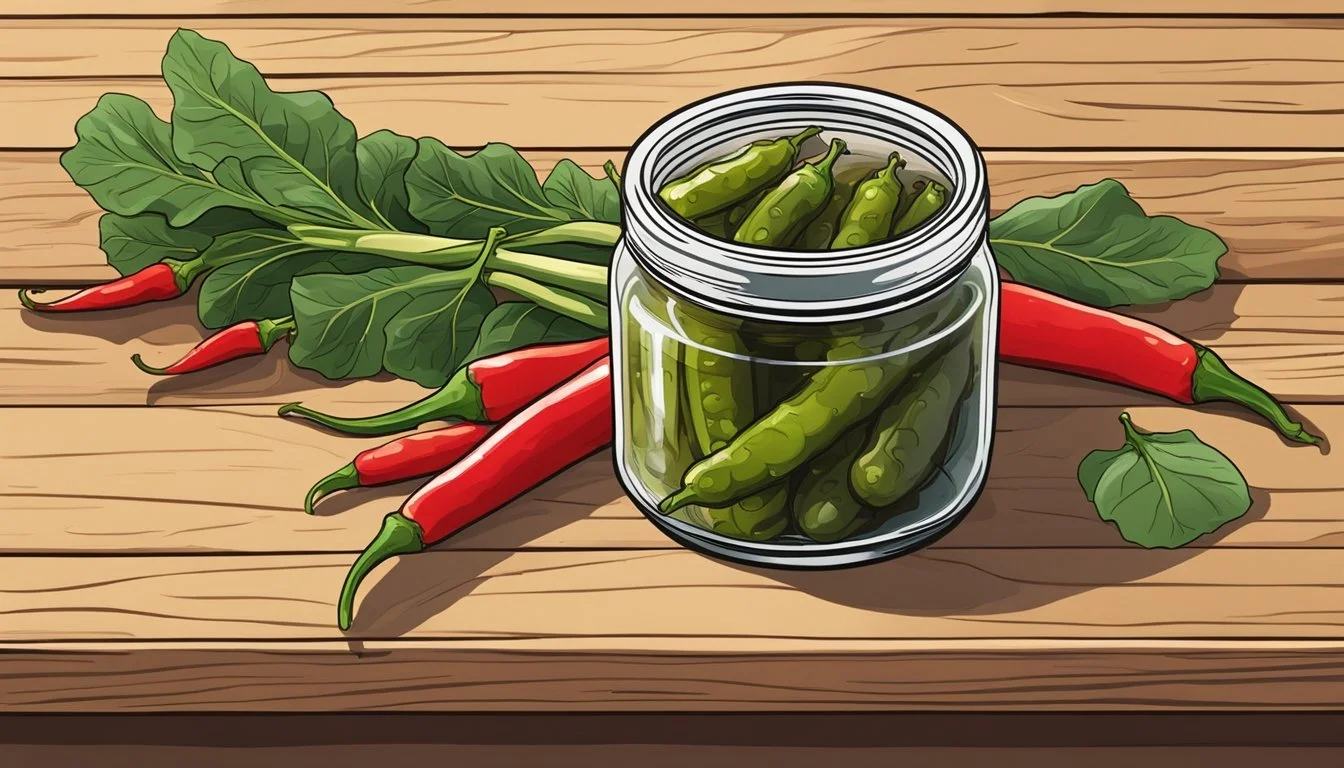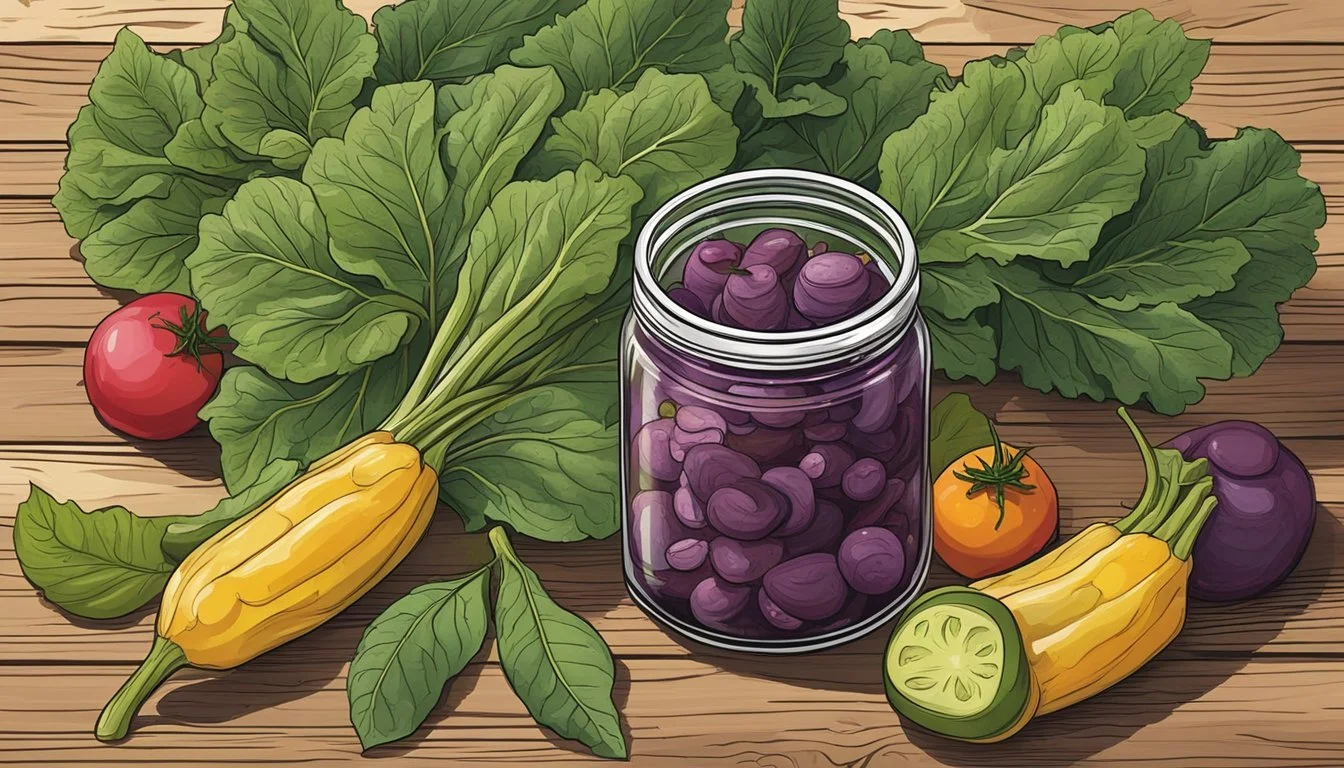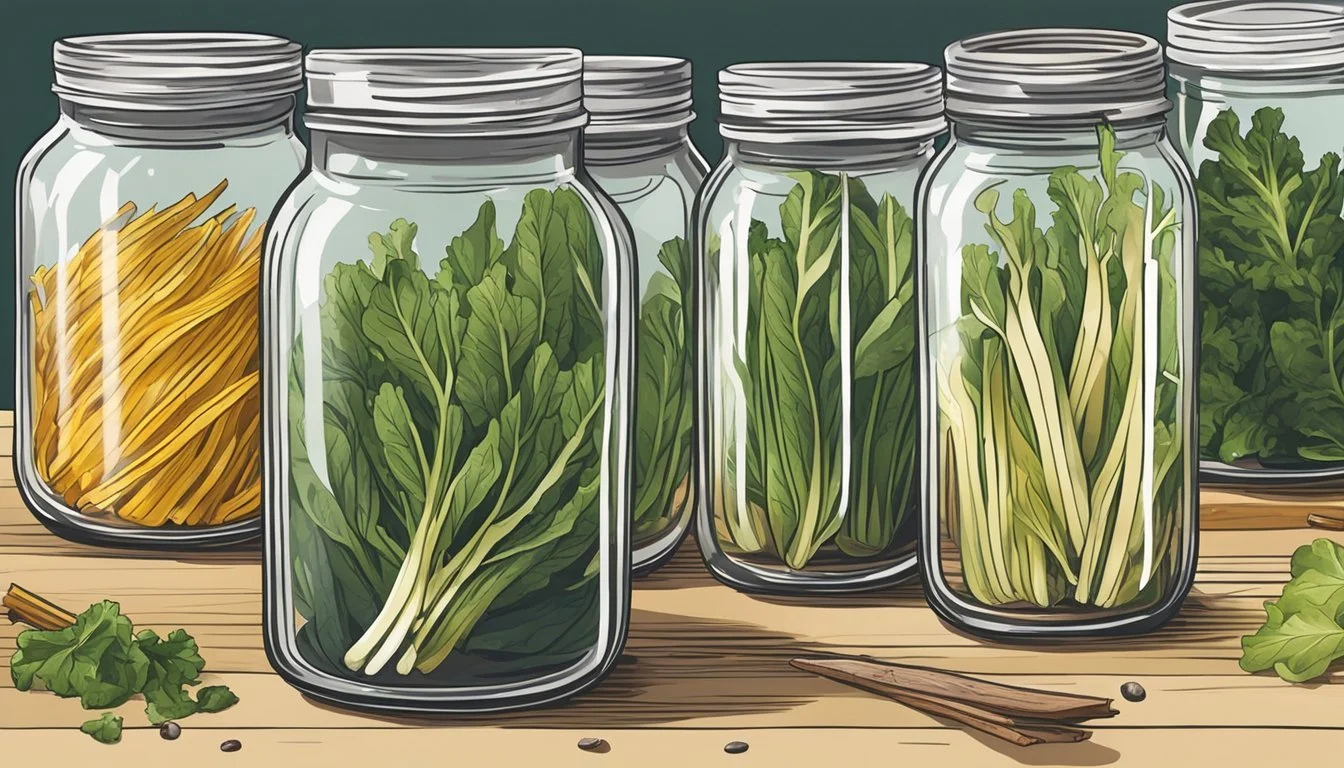Chard Stem Pickles
A Tangy, Probiotic-Rich Snack and Its Health Benefits
Chard stem pickles are capturing the attention of health-conscious food enthusiasts and home chefs alike. Made from the often-discarded stems of Swiss chard, these pickles offer an inventive twist to traditional pickling that food lovers are eager to explore. The stems' natural crunch and their ability to absorb flavors make them an excellent candidate for pickling, transforming them into a tangy, probiotic-rich snack. With the fermentation process, these stem pickles not only gain a unique flavor but also develop beneficial bacteria that can contribute to a healthy gut microbiome.
The process of creating chard stem pickles involves a simple brine, typically a mixture of vinegar, water, salt, and sometimes sugar or other sweeteners. This brine solution becomes the base within which the stems are submerged after being prepared and often blanched to optimize texture. The acidic environment of the brine solution encourages the growth of probiotics, making these pickles not just a flavorful addition to any meal but also a boon for digestive health.
The unique flavor of chard stem pickles varies widely depending on the specific recipe and additional spices used. Some might infuse heat with ingredients like sriracha or chili, while others may incorporate sweet undertones with maple syrup or sherry vinegar, resulting in a complex flavor profile that stands out among pickled foods. The versatility of chard stem pickles and the relatively straightforward method of preparation contribute to their growing popularity among those seeking to reduce food waste while still enjoying delicious and nutritious snacks (What wine goes well with snacks?).
The Basics of Pickling Chard Stems
Pickling chard stems is a simple process that adds flavor and extends the shelf life of fresh produce. The process involves using a brine made from vinegar, salt, and sugar along with various flavorings.
Ingredients and Tools
To pickle chard stems, one needs the following ingredients:
Chard stems: Fresh stems from a large bunch.
Salt: Kosher or pickling salt is preferable.
Sugar: To balance the saltiness and acidity.
Vinegar: A variety of vinegar can be used, such as white, apple cider, or rice wine.
Water: Ideally filtered, for making brines.
Spices: Such as dill, garlic, and mustard seed.
Flavorings: Including herbs, fruit peels, or additional spices.
Essential tools include:
Mason jars: With airtight lids to store the pickles.
Large bowl: For preparing brines.
Saucepan: To heat and dissolve the brine mixture.
Knife: For chopping the stems.
Cutting board: For prep work.
The Pickling Process
The process of making chard stem pickles typically involves the following steps:
Trimming: Chop the chard stems into pieces of uniform length that will fit in the jars.
Brining: Dissolve the salt and sugar in a mixture of vinegar and water heated in a saucepan.
Packing: Place chard stems and chosen spices into sterilized mason jars.
Pouring: Carefully pour the hot brine over the stems, ensuring they are completely submerged.
Sealing: Cap the jars with lids and leave to cool before refrigerating.
Understanding Brines
There are mainly two types of brines:
Vinegar brine: A mixture of vinegar, water, salt, and sugar, used for vinegar pickles.
Saltwater brine: Just salt and water, used for fermentation in making fermented pickles.
The concentration of salt and sugar in the brine can vary based on the recipe and desired taste.
Types of Pickles
Chard stem pickles fall into two categories:
Vinegar pickles: Which are quick and easy, involving a vinegar-based brine.
Fermented pickles: That rely on natural fermentation in a saltwater brine, known for their probiotic content.
Safety and Sanitation
Safe pickling practices are critical:
Sterilization: Before use, all jars and tools should be sterilized.
Seal: Proper sealing prevents contamination and ensures a longer shelf life.
Storage: Store pickles in the refrigerator to maintain safety and freshness.
Variations and Flavorings
Variations to the classic chard stem pickle recipe come from:
Herbs and spices: Dill, garlic, mustard seeds, and more can tailor the flavor.
Additional ingredients: Layers of flavor can be introduced with slices of fruit or additional spices.
Through customization, one can create a range of flavors, providing a unique homemade condiment or snack.
Health Benefits of Fermented Chard Stem Pickles
Fermented chard stem pickles offer a symphony of health benefits ranging from enhanced gut health to nutritional advantages, thanks to the presence of probiotics and a rich nutritional profile. They are a palatable approach to incorporating probiotic-rich foods into one's diet.
Probiotics and Gut Health
Probiotics are live bacteria that contribute to balanced gut health. Lacto-fermentation, the process used in making chard stem pickles, encourages the growth of these beneficial bacteria. Regular consumption of these pickles can promote a healthier gut microbiome, which is instrumental in improved digestion and overall wellbeing.
Nutritional Components
These pickles are more than just a low-calorie snack; they are a treasure trove of nutrition. They contain essential vitamins, such as Vitamin K and beta carotene, minerals, and antioxidants. Additionally, the fiber content aids in digestion, while potassium helps maintain electrolyte balance.
Digestive Harmony
The fermentation process fosters the production of lactic acid, which can enhance the body's ability to digest food effectively. This leads to digestive harmony, with less likely occurrences of minor stomach issues.
Chard Stem Pickles in Dietary Regulation
Incorporating chard stem pickles in the diet may aid in dietary regulation. The presence of probiotics can play a role in moderating blood sugar levels and, as a low-calorie snack, they can be part of weight management routines.
Probiotic Effects on Immune System
Probiotic-rich fermented foods like chard stem pickles enhance the immune system function. Regular intake might lower the frequency of infections and give an overall boost to the body’s defensive mechanisms against pathogens.
Considerations for Chronic Diseases
The regular consumption of fermented chard stem pickles can influence the management of chronic diseases. Their low sodium content may be beneficial for individuals monitoring their blood pressure or managing conditions like hypertension and kidney disease.
The Role of Fermenting in Preserving Nutrients
Fermenting not only extends the shelf life of the chard stems but also optimizes the preservation of nutrients. Unlike some cooking methods, lactic acid fermentation helps maintain and sometimes enhance the bioavailability of nutrients.
Practical Tips and Common Challenges
When making chard stem pickles, enthusiasts often prioritize maintaining the texture and flavor. Refrigeration, proper salinity, and careful monitoring of the fermentation process are crucial to success.
Storing Fermented Pickles
Proper storage of chard stem pickles extends their shelf life and preserves their probiotic richness. After the initial fermentation, pickles should be placed in the refrigerated section to slow down the fermentation. They can last for up to two weeks, retaining their crunchiness and tangy flavor.
Temperature: Keep below 40°F to maintain safety and quality.
Containers: Use airtight jars to prevent contamination.
Achieving the Perfect Crunch
The crunchiness of pickled chard stems is a signature texture that many aim for. Using a vinegar brine made of rice wine vinegar and sherry vinegar can enhance the crispness, while adequate salt concentration is essential in forming lactic acid, which contributes to the overall firmness.
Salt: Kosher salt is preferable due to its purity and taste.
Brine ratio: A balanced ratio ensures proper acidity.
Troubleshooting Fermentation Issues
During the fermentation process, one may encounter issues like slimy texture, mold, or off-flavors. These problems can arise from inadequate sterilization, incorrect brine proportions, or fluctuating storage temperatures.
Sterilization: Sterilize all equipment beforehand.
Observation: Regularly check for signs of mold or unusual smells.
Adjustments: If issues occur, adjust the brine and check storage conditions.
Creative Serving Suggestions
Chard stem pickles offer a unique flavor and nutritional value that can easily elevate various dishes and snacks. Their sour tang enhances the taste of meals while providing a healthy, low-calorie addition.
Pairing with Other Foods
Pairing chard stem pickles with other foods can add a delightful crunch and zest. They complement sandwiches well, especially when added alongside traditional ingredients such as ham, turkey, or roast beef. In salads, their acidic bite balances the creamy textures of avocado or hard-boiled eggs, and they can be chopped finely to mimic an olive or caper.
Charcuterie Boards: Chard stem pickles can stand beside an array of cheeses, meats, and fruits.
Grain Bowls: The pickles' acidity can contrast nicely with the savoriness of quinoa or rice.
Incorporating into Recipes
Chard stem pickles can be incorporated directly into recipes to impart their distinct sour tang. They can be diced and mixed into sauerkraut for an additional layer of flavor or sliced thinly to add a vinegary punch to kimchi. Their sturdy texture holds up well in cooking, allowing them to be integrated into hot dishes without losing their crunch.
Stir-Fries: Add towards the end of cooking for a vinegary snap.
Bruschettas or Crostinis: Top with a small piece of pickle to enhance the flavor profile.
Snack Ideas
Beyond their use in full recipes, chard stem pickles are a standout ingredient in quick, healthy snacks. One can enjoy them as is, similar to how one might eat carrot sticks or radishes. Alternatively, they can be used as a replacement for chips, offering a low-calorie, nutrient-rich snack option.
Dip Sticks: Serve with hummus or a yogurt-based dip.
Pickle Platter: Create a platter featuring an assortment of pickled vegetables, (What wine goes well with pickled vegetables?) including chard stems, carrots, and cucumbers.
Making Chard Stem Pickles Your Own
Pickling chard stems transforms a frequently discarded part of the vegetable into a delicious, probiotic-rich snack. By customizing the pickling process, home cooks can create a unique condiment that reflects their personal taste preference and pays homage to a variety of global pickling traditions.
Experimenting with Spice Blends
Every pickler knows that the blend of spices is what makes their pickles uniquely delicious. Mustard seed and black peppercorns are classic spices that offer a warm, piquant flavor. The adventurous may add aromatic dill seeds or a clove of garlic to the brine for a multilayered taste. Keeping track of a recipe with a successful spice blend can contribute to the collective repertoire of the pickling community through a recipe swap.
Enhanced Techniques for Advanced Picklers
While mastering the basics of pickling is straightforward, advanced picklers often incorporate techniques that elevate their pickles to the next level. Using fermentation crocks can create an anaerobic environment ideal for fermenting pickles. Incorporating a grape leaf at the bottom of the jar may help to keep pickles crisp by introducing tannins that inhibit enzymes softening the pickles.
The Influence of Pickling on World Cuisines
Pickling has a storied place in cuisines across the globe. Korean kimchi and German sauerkraut are excellent examples of how different cultures utilize fermentation to enhance and preserve vegetables. Chard stem pickles can be infused with spices from international pickling traditions to honor these time-tested techniques.
Community and Sharing
Home pickling creates an opportunity for community building and sharing. Neighbors exchange jars of pickles or share recipes, strengthening connections. Whether through social media or local pickling community meetups, home picklers enjoy showing off their creations and trading tips.
Sustainability and Home Pickling
Home pickling aligns with sustainable food practices, reducing food waste and promoting a zero-waste pickling approach. Home picklers utilize all parts of their produce, make large batches to last through the seasons, and recycle or reuse pickling jars, exemplifying how sustainability can be a delicious practice.
Conclusion
Chard stem pickles emerge as an exceptionally nutritious choice for those seeking probiotic-rich foods. The fermentation process enfolds these tangy stalks with good bacteria which can aid in improving digestion and bolstering gut health. These pickles are not just a low-calorie snack; they also offer a suite of health benefits typically associated with fermented foods.
Consumers should be mindful of the sodium content, as pickles do contain salt, which is essential in the fermentation process. However, when consumed in moderation, this does not detract from their nutritional value. They may also provide an assortment of vitamins that are inherent to chard stems.
Incorporating chard stem pickles into one’s diet can be an enticing way to augment one's intake of probiotics. They stand as a tangy and flavorful addition to meals or as a standalone snack while contributing to a well-rounded health regimen.
For those seeking to harness the energetic properties of fermented foods, chard stem pickles offer a homemade alternative that supports gut health without requiring significant culinary expertise to create. They underscore the harmonious balance between pleasing flavor and nutritional efficacy, underscoring their place as a beneficial component of a health-conscious diet.
References and Further Reading
"Gut-Friendly Pickles: Health Benefits Unveiled"
Author: Maya Shetty, BS
Highlight: This source discusses the broad health benefits of fermented foods, with a focus on the probiotic content of pickles and their positive effects on gut health, immunity, and digestion.
"Chard Stem Pickles - The New York Times"
Provides a recipe for chard stem pickles, including specific ingredient measurements and preparation instructions for those interested in making their own probiotic-rich snacks.
"The Best Brand Pickles With Probiotics - Fermenters Kitchen"
Published: February 21, 2021 (Updated: September 4, 2023)
A guide on identifying the best probiotic-rich pickle brands. Highlights include Bubbies, Olive My Pickle, and Kreugermann, noted for being raw and naturally fermented.
"Chard Stem Pickles Recipe - NYT Cooking"
Similar to the above, but includes additional details about the pickling process and time frames for the fermentation and refrigeration of chard stem pickles.
"Pickled Chard Stems - Upstate Ramblings"
An alternative recipe that offers a step-by-step guide to making chard stem pickles, including a unique touch with toasted mustard seeds for extra flavor.
Readers interested in exploring the topic of chard stem pickles and their probiotic benefits are encouraged to consult these sources for recipes, scientific research, and product buying guides.




